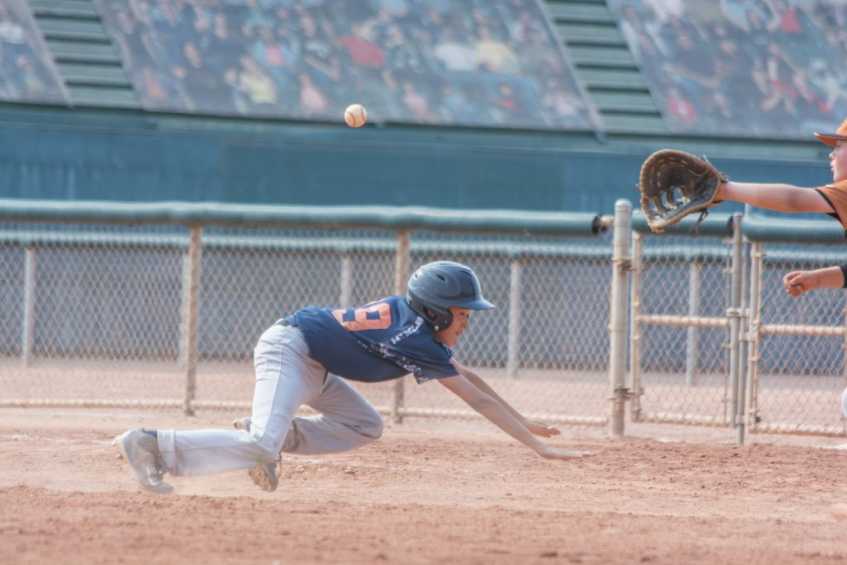
Of all the youth baseball players I have worked with over the years, the players that enjoy fielding as much as the other aspects of baseball, are the oneswho seem tohave the most love for the game and the playerswho usually advance far up the baseball ladder. If I have seen it once, I have seen it a thousand times, "Most young ball players love to hit and pitch, but practicing fielding is a another story." However,give me a young ballplayer who loves to play catch and field balls, and you have a real ballplayer on your hands.
Fielding is hard work, but like most athletic skills, the failure to do them often and correctly at a young age, makes it very difficult to "catch" on later. When kids hit, throw, and pitch, they exert obvious energy, but those skills are non-aerobic, or at least not as tiring as having to run after ground ballsand fly balls, as in fielding practice. For this reason, many kids just do not want to exert the energy to become good defensive ball players. This is unfortunate because many of these good hitting ball players have no position to play when they get to the high school level, thus failing to make the team for not having a defensive position to play. I continually remind youth baseballplayers that teams only bat one designated hitter but there are eight defensive positions that bat. It is a big challenge for parents and coaches to develop kids that love to field the ball as well as to work on fielding. Following are some helpful youth baseball fielding tips that might just do that.
Coaches should:
1. Practice with a softer ball - this allows the coach to challenge players with more speed and game like balls and eliminates kids' fear of being injured by the ball. Fear of the ball, usually caused by being plunked once or twice, is also a big deterrent for kids desire to practice fielding. Players will learn to get in front of and under the ball with the use of a safer ball, which is an essential fundamental when fielding. A protective fielder's cup is necessary for fielding practice and in games, of course.
2. Teach footwork, footwork and footwork, in that order. Great fielding begins with the feet from approaching the ball all the way through the throw.
3. Begin fielding practice with hitting or throwing slow ground balls so players can concentrate on the correct footwork as well as learning to charge the ball and be aggressive, as opposed to letting the ball come to them.
4. Teach kids when to catch balls with glove hand only (one-handedfor balls they reach for) and two hands for balls between their feet. The correct placement of their second-handfrom glove (slightly below, in front for line drives, slightly above, and in front for ground balls) is essential for two hand catching.
5. Avoid practicing ground balls on a smooth surface (indoors) whenever possible. Fielders get away with incorrect fundamentals indoors because hops are always true and predictable. Indoor fielding does not always promote good fielding habits, unless under the supervision of a well-qualified coach.
6.Have players field forten minutes or so as a way of getting loose for hitting and pitching practice.
7. Position non-hitting players and have them play balls off bat, as if in a game, during team batting practice. This is essential for outfielders to learn to judge fly balls, as it is much harder to mimic game-like fly ballswith fungo hit fly balls. Also see our list of the best baseball fungo bats for coaches!
8. Teach players to get into the correct "ready" position before the pitched ball reaches the hitter.
9. Practice game like situation practice - knowing what to do in the game (i.e. where to throw ball, what base to cover) on defense is very important. Having kids play different positions in practice (individually or with team) is always a good thing, too.
10. Remind kids of the importance of throwing, both arm strength and accuracy, to fielding success. Plays are usually only half over with catches. Completing plays with good throws is necessary. When a softer ball is not used for fielding practice, having young kids wear a face guard will help them feel safe. Of course, after working on the fundamentals with a softer ball, depending on age and skill level of players,transitioning toa regular hard ball is necessary at some point.
After playing major league baseball, Jack Perconte has taught baseball and softball since 1988 and offered valuable coaching training too. He has helped numerous youth players reach their potential, as well as having helped parents and coaches navigate their way through the challenging world of youth sports. Jack is one of the leading authorities in the areas of youth baseball training and coaching training advice.
All Jack Perconte articles are used with copyright permission.There are 0 comments on "Youth Baseball Fielding Tips from Former Major League Second Baseman"
chandler allen says:
"Hi my name is chandler, i’ve enjoyed..."
On Wanting to tryout for summer ball. as an 18 year old
david graham says:
"With no current MLB team in Canada,..."
On With no current MLB team in
Charles Chavez says:
"To All Coaches: Do you have13U or..."
On Looking for Games